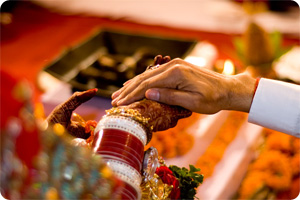Kanyadaan

A Hindu Wedding is very elaborate and ritualistic. There are several compulsory rituals in a Hindu wedding that hold immense significance and deep rooted meaning in the Hindu Religion. The rituals of the Hindu wedding ceremony start days before the actual wedding ceremony. Sagaai is the first step towards the formal announcement of a marriage which is followed by various other rituals like Sagan, Haldi, Sangeet and Mehandi. Apart from the religious and ritualistic nature, a Hindu wedding is also quite an emotional affair. The most emotional of all the rituals of the Hindu Marriage is Kanyadaan when the father hands over all his rights and duties towards his daughter to her prospective groom.
On the wedding day, the complete marriage ritual last lasts for hours due to several small and big customs that are considered auspicious as well as vital for solemnizing a marriage. Among all the main day wedding rituals, kanyadaan is the most vital and significant ritual. Kanya Daan literary means gifting away a virgin, the word is actually a combination of two words, Kanya and Daan, where in Kanya means a virgin and Daan means donation.
The ritual of Kanya Daan is performed just before the Mangalphere. Kanyadaan is a ritual in which the bride's father entrust her daughter to the groom, who is at the time of marriage considered to be a form of Lord Vishnu. As a condition for offering his daughter to the groom for marriage, the father of the bride asks a promise from the groom for assisting the bride in achieving three important goals of the life- dharma, artha, and kama. The ritual of Kanya Daan is considered very auspicious in Hindu religion. It is a very pious and dutiful ritual which is said to bring fortune as well as relief from the sins for the bride's parents.
In the ritual of kanyadaan the bride's parents normally her father or in his absence any elderly relative give their daughter to the groom by putting the bride's right hand into the groom's right hand (Hastamelap, which means joining of hands) while reciting sacred verse. The curtain separating the bride and groom is then removed and then the couple exchange flower garlands. When the father of the bride gives away his daughter to the groom, followed by the offering of gifts and presents, then the elders of the family place an auspicious white cotton cord around the couple's shoulder's to protect them from ill omen since cotton signifies unity, the bride and the groom shower each other with rice. This ritual is a symbol of couple's bond and love. The groom holds the bride's hand and they both take vows to love, be loyal, committed and protect each other throughout their life.
| |
Other Categories
Arya Samaj Wedding
Christian Wedding Ceremony
Hindu Marriage Act
Muslim Wedding Ceremony
Indian Wedding Facts
Kanyadaan
Marriage Legalities in India
Sikh Wedding Rituals
Parsi Wedding Ceremony
Special Marriage Act
Muslim Marriage Act
Marriages in Different Religions
Famous Indian Weddings
Seven Vows Of Marriage
Indian Baraat
Wedding Photography
Main Categories
Indian Weddings
Wedding Decoration Tips
Pre Wedding Functions
Post Wedding Functions
Hindu Marriages
Indian Wedding Day Functions
Muslim Wedding Ceremony
Malayalee Wedding Ceremony
Kannada Wedding Ceremony
Kashmiri Wedding Ceremony
Oriya Wedding Ceremony
Tamil Wedding Ceremony
Bengali Wedding Ceremony
Punjabi Wedding Ceremony
Jain Wedding Ceremony
Maithil Brahmin Wedding Ceremony
Sindhi Wedding Ceremony
Telugu Wedding Ceremony
Maharashtrian Wedding Ceremony
Assamese Wedding Ceremony
Jewish Wedding Ceremony
Marwari Wedding Ceremony
Buddhist Wedding Ceremony
Gujarati Wedding Ceremony
Planning Your Honeymoon
Indian Bride
Indian Groom
Indian Wedding Features
Marriage Problems
Indian Wedding Preparation
Indian Wedding Planners
Post Wedding Preparation
Main Day Function
|

